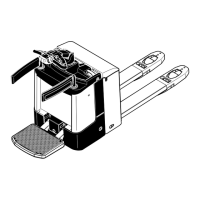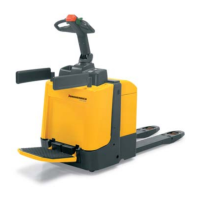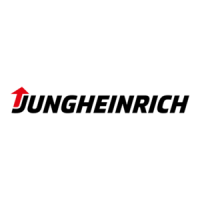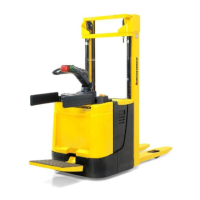03.13 EN
4
4 Lead acid batteries with armour plated cells and liquid
electrolyte
4.1 Description
Jungheinrich traction batteries are lead acid batteries with armour plated cells and
liquid electrolyte. The names of the traction batteries are PzS, PzB, PzS Lib and PzM.
Electrolyte
The rated density of the electrolyte assumes a temperature of 30°C and the rated
electrolyte level is fully charged. Higher temperatures will reduce, lower temperatures
will increase the electrolyte density. The adjustment factor is ± 0.0007 kg/l per K, e.g.
electrolyte density 1.28 kg/l at 45°C corresponds to a density of 1.29 kg/l at 30°C.
The electrolyte must conform to DIN 43530 Part 2 purity regulations.
4.1.1 Battery nominal data
1. Product Traction battery
2. Nominal voltage 2.0 V x no. of cells
3. Rated capacity C5 See data plate
4. Discharge current C5/5h
5. Nominal electrolyte density
1
1. Reached within the first 10 cycles.
1.29 kg/l
6. Nominal temperature
2
2. Higher temperatures shorten the useful life, lower temperatures reduce
the available capacity.
30 °C
7. System rated electrolyte level up to "Max" electrolyte level marking
Limit temperature
3
3. Not permissible as operating temperature.
55°C
03.13 EN
4
4 Lead acid batteries with armour plated cells and liquid
electrolyte
4.1 Description
Jungheinrich traction batteries are lead acid batteries with armour plated cells and
liquid electrolyte. The names of the traction batteries are PzS, PzB, PzS Lib and PzM.
Electrolyte
The rated density of the electrolyte assumes a temperature of 30°C and the rated
electrolyte level is fully charged. Higher temperatures will reduce, lower temperatures
will increase the electrolyte density. The adjustment factor is ± 0.0007 kg/l per K, e.g.
electrolyte density 1.28 kg/l at 45°C corresponds to a density of 1.29 kg/l at 30°C.
The electrolyte must conform to DIN 43530 Part 2 purity regulations.
4.1.1 Battery nominal data
1. Product Traction battery
2. Nominal voltage 2.0 V x no. of cells
3. Rated capacity C5 See data plate
4. Discharge current C5/5h
5. Nominal electrolyte density
1
1. Reached within the first 10 cycles.
1.29 kg/l
6. Nominal temperature
2
2. Higher temperatures shorten the useful life, lower temperatures reduce
the available capacity.
30 °C
7. System rated electrolyte level up to "Max" electrolyte level marking
Limit temperature
3
3. Not permissible as operating temperature.
55°C

